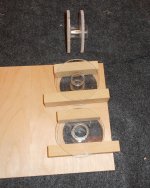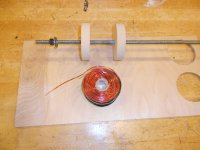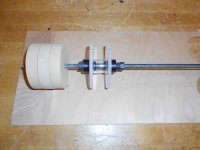Well that's a huge difference!! I do find the 2mh and 20mh settings are slightly different, but not much a 0.1 e.g. (not bad at all, and there is the lower setting). I've been checking "store bought stuff", and it seems to work fine.
The cost of copper is crazy, the inductors can cost more then manufactured drivers! Been trying to make up bobbins quickly, these went really fast, just a few minutes; the center "dowel" is 1" so used a flat spade bit and had a nice fit.
The sides are 3-1/4", the ID width is 1", which will make a nice/neat 1.5mh 14g inductor once finished.
Clear epoxy seems to work better than CTA.
The cost of copper is crazy, the inductors can cost more then manufactured drivers! Been trying to make up bobbins quickly, these went really fast, just a few minutes; the center "dowel" is 1" so used a flat spade bit and had a nice fit.
The sides are 3-1/4", the ID width is 1", which will make a nice/neat 1.5mh 14g inductor once finished.
Clear epoxy seems to work better than CTA.
Attachments
Last edited:
This is OT here, but anyway. 1/2 turn exists on paper, it is the visible part, there can be magnetic field and flux in a closed loop only. Similarly you don't see stray capacitance at UHF but it is there nonetheless.Yes there is.
Very much used in UHF transmitters or receivers.
Sometimes referred to as "U" turn or "U" coil, for obvious reasons.
Just cut and pasted from UHF schematics and datasheets:
or
Neither has importance in audio...
On paper?1/2 turn exists on paper,
Tell that to the UHF transmitter/Ham/TV/Satellite/Radar/etc. guys who build them in the flesh.
Ok, in the copper
Sorry but maybe you mised that class in Electronics 101.there can be magnetic field and flux in a closed loop only.
A "0 turn" coil, a.k.a. straight wire, can and does have inductance.
Inductance of a Straight Wire: A Calculator
Is it "irrelevant" at audio frequencies?
Not at all, the page cited above says:
This can be important if you are dealing with low impedances (< 1 ohm) at high frequencies (> 10kHz).
Meaning it must be taken seriously in, for example, power rails, speaker out and **GROUND** when an "unseen" but very real 1 ohm frequency dependent impedance may be the cause of instabilities and oscillation.
Maybe there is a reason, after all, why decoupling caps must be placed as close as possible to the part being decoupled.
Might it be another dread of that evil straight wire inductance?
A very real and practical everyday problem.
"you don't see means it does not exist there?Similarly you don't see stray capacitance at UHF but it is there nonetheless.
"but it's there" Contradicting.
Just explained the importance of stray inductance in Audio.Neither has importance in audio...
Now you say that stray capacitance is also irrelevant in audio?
People struggling to get correct trouble free layouts might disagree with your blanket statements.
So my little ploy worked pretty good - Son and I did this in a few minutes and good for him since he's in electrical school (then he can explain inductance to me  )
)
Made up a drive tool for the battery drill - I think a good tip may be let the "Axel" stick out on both sides that can be trimmed later. That way the nuts/bolt won't crush the sides and break glue joints on spool.
Made up a drive tool for the battery drill - I think a good tip may be let the "Axel" stick out on both sides that can be trimmed later. That way the nuts/bolt won't crush the sides and break glue joints on spool.
Attachments
Found some plastic spacers (black parts) in the junk barrel - this will hold. Also the lead wire going thru the spool can be used to keep things from spinning.
The magnet wire cam be found here: McMaster-Carr
The magnet wire cam be found here: McMaster-Carr
Attachments
- Status
- This old topic is closed. If you want to reopen this topic, contact a moderator using the "Report Post" button.
- Home
- Design & Build
- Equipment & Tools
- Which Inductance Meter to buy?


